
Chromodoris purpurea
(Risso in Guérin, 1831)
Order: NUDIBRANCHIA
Suborder: DORIDINA
Superfamily: EUDORIDOIDEA
Family: Chromodorididae
DISTRIBUTION
Western Mediterranean, east Atlantic coast from Morocco to southern France.
PHOTO
Northern Spain. Photo: Angel Valdes
Pale translucent pink mantle and orange yellow border. Differs from other similarly coloured species from the region in lacking any colour markings, (lines, spots) on the mantle other than the border.
Reference:
• Schmekel, L. & Portmann, A. (1982) Opisthobranchia des Mittelmeeres. Springer-Verlag: Berlin. 410pp.
Rudman, W.B., 2001 (January 22) Chromodoris purpurea (Risso in Guérin, 1831). [In] Sea Slug Forum. Australian Museum, Sydney. Available from http://www.seaslugforum.net/find/chropurp
Related messages
Re: Chromodoris purpurea from Israel
July 6, 2006
From: Leslie Harris
Concerning message #17049:
Dear Bill --
It's certainly possible that the Hermodice could have been attracted to a damaged nudibranch but there's no way of knowing in this particular case. It would be interesting to test the theory and see if C. purpurea's chemical defenses are enough to deter a hungry fireworm.
As for the damaged area, here's an alternate scenario as witnessed by my friend Kevin Lee yesterday in southern California. "I happened upon a Noble Dorid (Peltodoris nobilis ) which measured a whopping 2.5 inches!... in my experience, an inch or less is the norm here... stayed with it awhile... senoritas or garibaldis, seeking a quick snack, would swing by and
peck on its rhinophores & branchial plume so both were retracted... thus, I spent a good 5 minutes shooing away the pesky varmits, until the plume and rhinophores re-appeared for the photo op...."
Cheers,
Leslie
lharris@nhm.org
Harris, L.H., 2006 (Jul 6) Re: Chromodoris purpurea from Israel. [Message in] Sea Slug Forum. Australian Museum, Sydney. Available from http://www.seaslugforum.net/find/17073Thanks Leslie,
Best wishes,
Bill Rudman
Re: Chromodoris purpurea from Israel
July 5, 2006
From: Leslie Harris
Concerning message #17038:
Hi Bill, Fabio, & Joseph --
A Hermodice carunculata eating a healthy nudibranch would be a first. This species has two main feeding modes - scavenging on dying & dead organisms & eating live polyps. Aquarists consider H. carunculata a demon from hell as it can do considerable damage to prized corals, gorgonians, & anemones! The worm engulfs the food item with its everted proboscis. Jaws are lacking; the food item is either swallowed whole or broken down by muscular action of the proboscis & secreted enzymes & then ingested.
It's not unusual for motile organisms to cross paths. Just think of how many shots of nudibranchs crawling on fish or other organisms have been sent to the Forum. I would be very surprised if the fireworm was really responsible for the damage on the Chromodoris.
Regards,
Leslie
lharris@nhm.org
Harris, L.H., 2006 (Jul 5) Re: Chromodoris purpurea from Israel. [Message in] Sea Slug Forum. Australian Museum, Sydney. Available from http://www.seaslugforum.net/find/17049Dear Leslie,
Thanks for your comments. I had forgotten that fire worms even lack teeth-like paragnaths on their proboscis. Why I asked Yossi if the worm had more than passing interest in the slug, was that the worm definitely has its head just in the spot where there is damage on the slug's mantle. Perhaps it was attracted to the wound?
Best wishes,
Bill Rudman
Re: Chromodoris purpurea from Israel
July 3, 2006
From: Fabio Russo
Concerning message #17018:
Dear Bill,
The polychaete worm you can see in the photo of this message is a fire worm named Hermodice carunculata. I'm pretty sure that this worm was eating the Chromodoris!
Best Regards
Fabio
scercola@alice.it
Russo, F., 2006 (Jul 3) Re: Chromodoris purpurea from Israel. [Message in] Sea Slug Forum. Australian Museum, Sydney. Available from http://www.seaslugforum.net/find/17038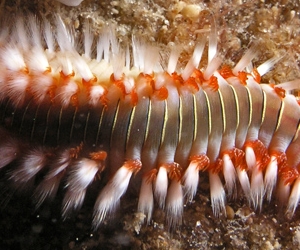
Thanks Fabio,
I would be interested if you have other observations of these worms eating nudibranchs. For those of you not familiar with 'fireworms' they get their common name from the sting they can give you if you unfortunately brush against them. In the close-up from Yoshi Elayani's photo alongside, the bundles of capillary bristles can be seen quite clearly. These bristles break off once they have pierced your skin, releasing a poison which causes quite a fiery allergic reaction.
Best wishes,
Bill Rudman
Re: Chromodoris purpurea from Israel
July 3, 2006
From: Joseph Elayani
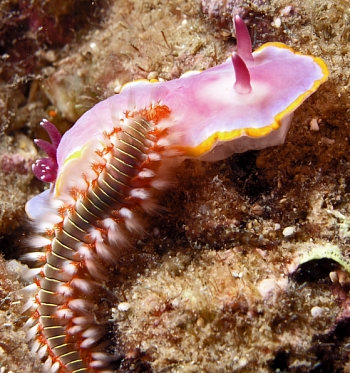
Concerning message #17018:
Dear Bill ,
First I noticed the egg mass and then began searching for the "beauty". I found it one meter from the eggs .
The worm came from nowhere and start harassing (on top) then stopped and started again but the "beauty" put an end to the story. After climbing on the worm's head they separated .
Regards,
Joseph
elayani@gmail.com
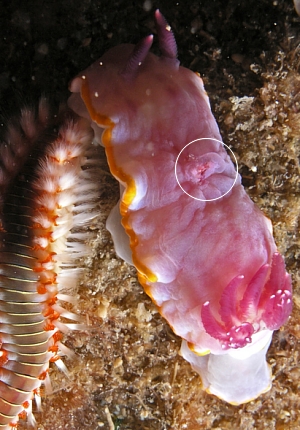
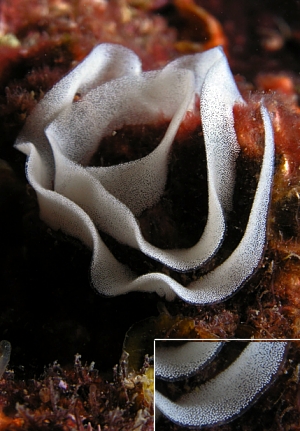
Dear Yossi,
It's certainly a possibility that the chromodorid produced the egg ribbon, but it could just be a coincidence. It will certainly be worth looking out for more occasions when this species is found near this type of egg ribbon. Your worm observation is quite interesting. I thought I had noticed a bit of damage on the back of the nudibranch in your earlier photos and it certainly looks as though the worm actually had a bite or two before giving up for some reason. I can't recall other observations of polychaetes eating or biting nudibranchs so this is a valuable record.
Best wishes,
Bill Rudman
Chromodoris purpurea from Israel
July 1, 2006
From: Joseph Elayani
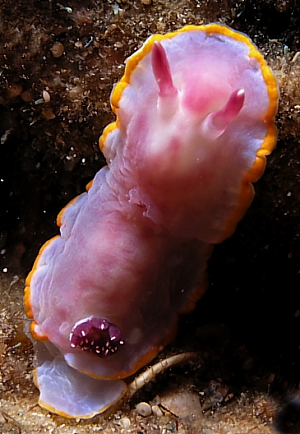
Hi Bill ,
This ID as Chromodoris purpurea was made by Matan from the local Israeli slug fourm but this slug looks like giant compared (at least 7 cm long) to the average 2 cm other reported .
Locality: Caesarea ,Underwater Archeological Park, 7 meters, Israel, Mediterranean Sea, 23 Jun 2006, Rocky bottom. Length: 7 cm. Photographer: Elayani Joseph.
Best Regards ,
Joseph
elayani@gmail.com
Elayani, J., 2006 (Jul 1) Chromodoris purpurea from Israel. [Message in] Sea Slug Forum. Australian Museum, Sydney. Available from http://www.seaslugforum.net/find/17018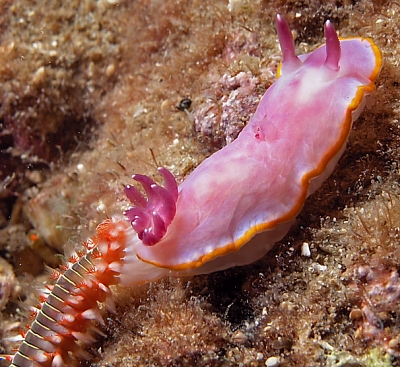
Dear Yossi,
Thanks for this 'giant'. I am not sure how large it grows but certainly records on the Forum are no longer than 30 mm. If you ever see it laying eggs or on a sponge, photos would be very welcome. I must say I am very attracted to the colourful polychaete worm. Was it harassing the chromodorid or did their paths just cross?
Best wishes,
Bill Rudman
Chromodoris purpurea? from Cannes
June 27, 2006
From: Dominique Horst
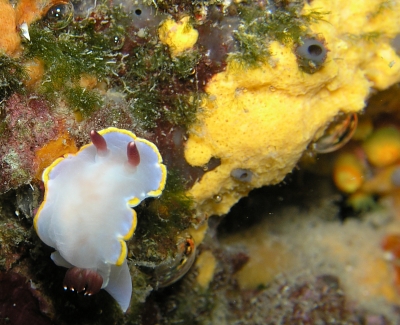
Hi Bill,
Another request for identification of the following dorid. A friend of mine, found this dorid yesterday. After a short discussion between us (in our emergent slugs fan club...), we decided on Chromodoris purpurea...
Would you be so kind to give us your point ?
Locality: Ste Marguerite Island, 25m, Cannes, Mediterranean sea, 22 June 2006, vertical rock. Length: 20 mm. Photographer: Helene Delaitre.
Many thanks in advance,
Kind regards,
Dominique
dominique.horst@wanadoo.fr
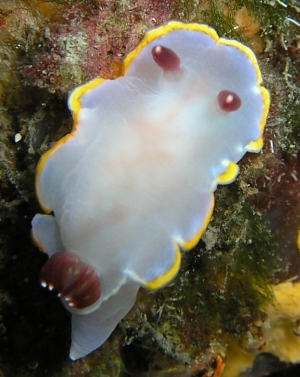
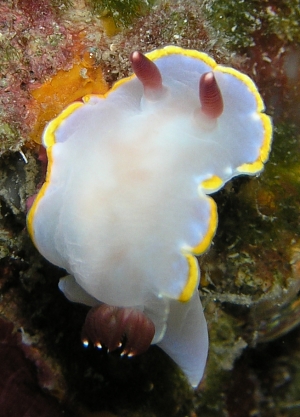
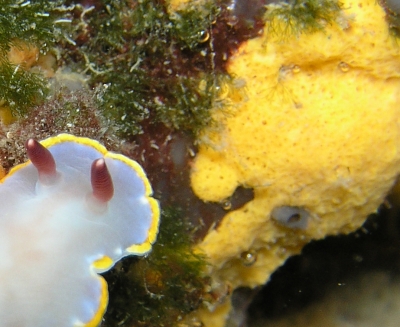
Dear Dominique,
A good decision. Yes this is C. purpurea, as species we know little about. On valuable aspect of your message is the bright yellow sponge alongside, which looks very much like Aplysilla sulfurea Schulze, 1878 to me.
Ortea & Perez (1983) mention that the food of C. purpurea is Aphyrilla sulfurea, which I assume is a mispelling from Aplysilla sulfurea. This makes Helene's photo the first possible confirmation of Ortea & Perez's observation. As I have said before being close to a sponge is not positive proof of feeding, but it is certainly a good enough indication to ask you to keep an eye out for this nudibranch on yellow sponges.
-
Ortea, J.A. & Perez, J. (1983: Dos Chromodorididae "Violeta" del Atlantico nordeste. Vieraea 12: 61-74.
Best wishes
Bill Rudman
Chromodoris purpurea from Portugal
May 4, 2006
From: David Abecasis
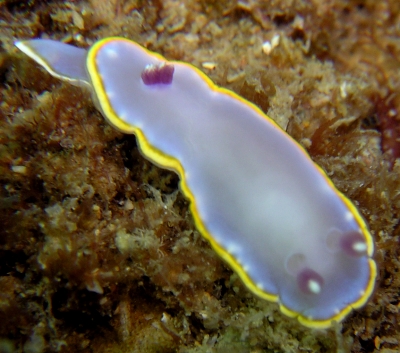
Hi Bill,
I believe this species is Chromodoris purpurea. Can you confirm it?
Locality: Praia do Burgau, Lagos, 8 metres, Portugal, Atlantic Ocean, 30 April 2006, wreck in sandy bottom. Photographer: David Abecasis.
Thanks,
David Abecasis
davidbecas@netcabo.pt
Abecasis, D., 2006 (May 4) Chromodoris purpurea from Portugal. [Message in] Sea Slug Forum. Australian Museum, Sydney. Available from http://www.seaslugforum.net/find/16514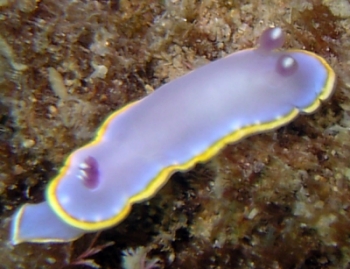
Dear David,
Although I have learnt to be cautious in identifying European chromodorids, I am pretty sure this is C. purpurea. I would be very interested in photos of any of these chromodorids your are finding on possible food sponges. I know they can be very frustrating at times, but surely they must have to stop and eat now and then.
Best wishes,
Bill Rudman
Chromodoris purpurea from Portugal
March 15, 2006
From: Paulo Trindade
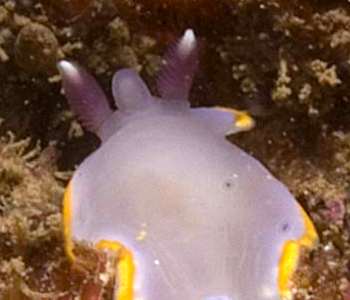
Hi Bill
I write to you for the first time because I have no idea what could have caused this deformation between the rhinophores of this Chromodoris purpurea.
Locality: Baleal, 5 to 7 meters, Portugal, Atlantic, 25 February 2006, Rocky bottom. Length: between 15 and 25 mm. Photographer: Paulo Trindade
Thank you
Best regards
Paulo Trindade
paulus_60@clix.pt
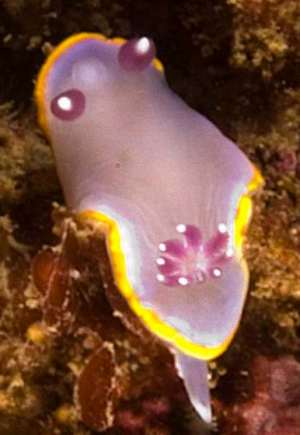
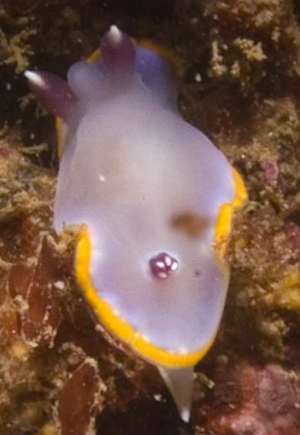
Dear Paulo,
We know very little about the abnormalities, illnesses and parasites which affect nudibranchs. I suspect this may be a cyst containing perhaps a copepod, or at least a crustacean, parasite. If anyone has any ideas they would be welcome. Have a look at the parasite Fact Sheet for some further ideas, and the Abnormalities page.
Best wishes,
Bill Rudman
White Chromodoris purpurea from Azores
December 9, 2005
From: David Abecasis
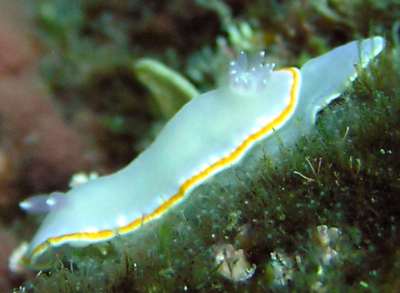
Hi Bill,
I would like your confirmation on the identification of this nudibranch. I've identified it as Diaphorodoris luteocincta but I'm not sure.
Locality: Faial, Azores Islands, Portugal. Atlantic Ocean. Depth: 12 metres
19 June 2005. rocky . Photographer: David Abecasis
David Abecasis
dabecassis@ualg.pt
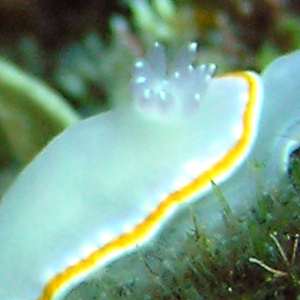
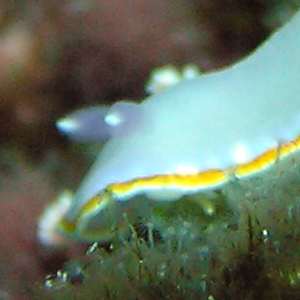
Dear David,
Although this animal has similarities to Diaphorodoris luteocincta and also to some white chromodorids, I am pretty sure this is Chromodoris purpurea. On the whole it lacks the purplish colouration of the mantle and body which gives this species its name, but there is still a distinct purplish tinge on the gills and the rhinophores and a distinct opaque white tip to each rhinophore and gill, whichbas you will see on other photos on the Forum, are characteristic of C. purpurea. A look at its anatomy would be needed to confirm this identification, but C. purpurea has been reported from the Azores. You don't give any indication of its size. Maybe smaller animals lack the purplish tinge of older animals?
Best wishes,
Bill Rudman
Chromodoris purpurea from Turkey
September 6, 2003
From: Ferda Buyukbaykal
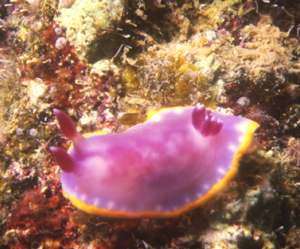
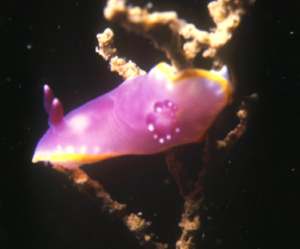
Dear Bill,
I took these photos in 1994, I suppose they are also Chromodoris purpurea also. I hope they are of some value.
Date: July 1994
Location: Mersin, Tasucu, Turkey
Site: Dana adasi
Depth: 24m
Size: 20-25mm
Photos: Ferda Buyukbaykal
Best wishes
Ferda
ferdabbaykal@isnet.net.tr
Buyukbaykal, F,, 2003 (Sep 6) Chromodoris purpurea from Turkey. [Message in] Sea Slug Forum. Australian Museum, Sydney. Available from http://www.seaslugforum.net/find/10850Thanks Ferda,
Yes these are a very useful addition, showing a form of the species with a very definite purple background, to match its name.
Best wishes,
Bill Rudman
Re: Chromodoris purpurea from Turkey
August 26, 2003
From: Bill Rudman
I should have mentioned in my comment on Chromodoris purpurea that Ortea & Perez (1983) compare this colour form with C. britoi in their description of that species. They have a photo from the Canary Ids almost identical in colour to Ferda's photo from Turkey. They mention the food of C. purpurea is Aphyrilla sulfurea, which I assume is a mispelling from Aplysilla sulfurea?
Bill Rudman
Chromodoris purpurea from Turkey
August 25, 2003
From: Ferda Buyukbaykal
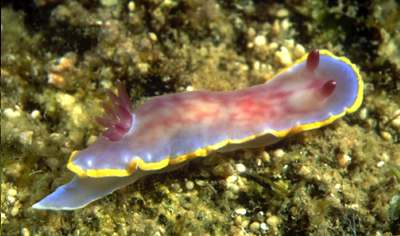
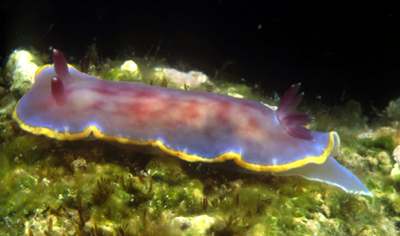
Dear Bill,
Could you identify this photo please? - Chromodoris purpurea or C. britoi?.
Date: July 02 , 2003
Location: Antalya, Kekova
Site: Akar bogazi
Depth: 08-10 mt
Size: 25-30 mm
Photos: Ferda Buyukbaykal
Best regards
Ferda
ferdabbaykal@isnet.net.tr>
Buyukbaykal, F., 2003 (Aug 25) Chromodoris purpurea from Turkey. [Message in] Sea Slug Forum. Australian Museum, Sydney. Available from http://www.seaslugforum.net/find/10815Dear Ferda,
I am pretty sure this is C. purpurea. In specimens from the western end of the Mediterranean the dark purplish mottling on the mantle often seems to be less noticeable. According to Angel Valdes, in C. britoi there are always yellow lines. Thanks for these photos, they give us a better idea of the colour variability of this species
Best wishes,
Bill Rudman
Chromodoris purpurea from Mediterranean France
June 25, 2002
From: M. Poddubetskaia
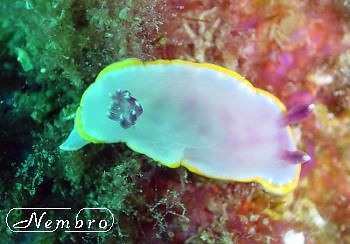
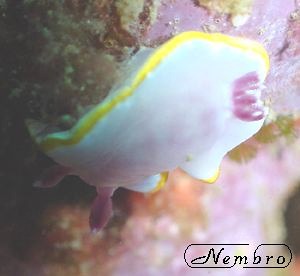
Dear Bill,
Here are two photos of Chromodoris purpurea.
Cap Croisette (near Marseille), France., Site: Passe de Maire. Depth: 11m., Size: approx 2cm. 5 June 2002.
Best wishes,
Marina.
nembro@nembro.info
Poddubetskaia, M., 2002 (Jun 25) Chromodoris purpurea from Mediterranean France. [Message in] Sea Slug Forum. Australian Museum, Sydney. Available from http://www.seaslugforum.net/find/7302Thanks Marina,
Bill Rudman
Chromodoris purpurea from Spain
January 24, 2001
From: Angel Valdes

Dear Bill,
To accompany my message about Chromodoris krohni, here is a photo from northern Spain of Chromodoris purpurea (Risso in Guérin, 1831), which is very similar in colour but lacks yellow lines.
Angel Valdes
avaldes@CalAcademy.org
Valdes, A., 2001 (Jan 24) Chromodoris purpurea from Spain. [Message in] Sea Slug Forum. Australian Museum, Sydney. Available from http://www.seaslugforum.net/find/3613Thanks Angel,
Bill Rudman
